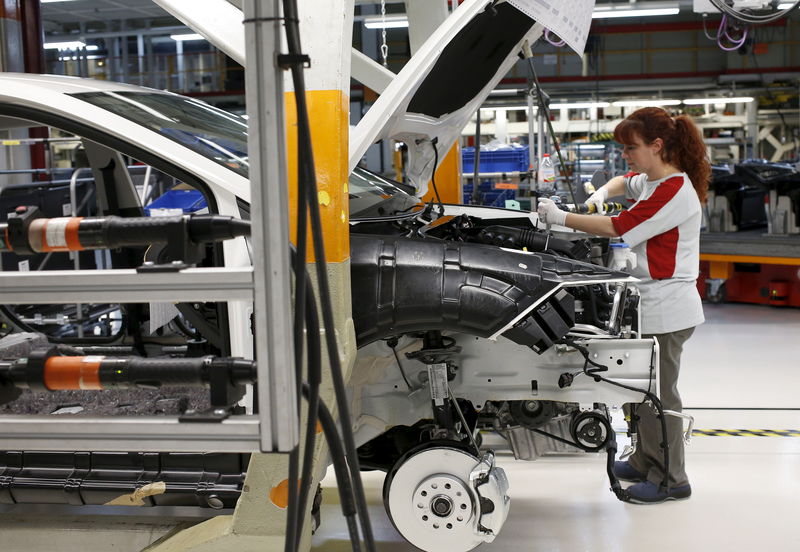(Bloomberg) -- On one side of the bargaining table will be union brass angry about plant closures and embarrassed by scandal. On the other will be auto executives sweating shrinking sales and risky billion-dollar bets to survive an era of disruption.
Thus is the difficult backdrop the United Auto Workers and Detroit Three have to overcome to clinch new four-year labor contracts. Negotiations kick off this week with handshake ceremonies that will belie the tension between one of the largest U.S. unions and car manufacturers employing almost 150,000 members.
General Motors Co (NYSE:GM). riled the union months ago by putting four U.S. factories on the chopping block. Fiat Chrysler Automobiles NV and its UAW counterparts are still dealing with the legal fallout from ex-union and company officials draining millions from a union training fund to enrich themselves. And Ford Motor (NYSE:F) Co. is said to be prepared to ask hourly workers to pony up more for health care that will otherwise cost the carmaker dearly next year.
Here’s a look at the key issues heading into this year’s talks:
Protecting Plants
GM’s shock decision to cut off any future product from car and powertrain plants in Michigan, Ohio and Maryland incensed the UAW and made the company a target of criticism from President Donald Trump, Democratic candidates and members of congress.
UAW Vice President Terry Dittes isn’t going to let those factories go down without a fight. The head of the union’s GM department has said those plants “will not be forgotten” and hopes to secure work for members at every one of the facilities. It’ll be an uphill climb, especially with GM’s shuttered Chevrolet Cruze plant in Lordstown, Ohio, which it’s trying to sell to electric truck maker Workhorse Group Inc.
The union has less of a beef on this front with Fiat Chrysler, which is planning to hire 6,500 workers to boost Jeep SUV and Ram truck output, and Ford, which is currying favor with big investments to build electric and self-driving vehicles in Michigan. But the union is still going to battle for whatever job security measures it can secure for other factories even though the U.S. auto market is shrinking.
Temp Workers
The Detroit automakers were able to offset some of the additional labor cost added by handing out raises during the last round of contracts in 2015 by convincing the UAW to let them employ more temporary workers. These arrangements are helpful when the companies need extra help to launch a new model or cover summer vacation schedules.
But GM’s desire to bring on more temp workers is going to run headlong into UAW leadership, who heard an earful during their bargaining convention in March. Members were fired up about limiting use of temps because they’re paid less, are eligible for skimpier benefits and have weaker protections under the union contract.
“How can these companies -- given the uncertainty of the business and where they are in the cycle -- honor any investment commitments?” said Dan Luria, former research director with the Michigan Manufacturing Technology Center, and past adviser to the UAW. “That will require some givebacks by the union -- it will have to be on temps.”
Health Care
UAW members have some of the best health-care benefits in America, contributing just 3% to their own coverage, compared with 29% for the average employee-covered family plan, according to the Kaiser Family Foundation.
Automakers are crying uncle, with a source at Ford saying health-care costs for its 56,000 hourly workers will top $1 billion next year for the first time. GM pays about $900 million a year for the health benefits of its U.S. hourly staff.
To reduce runaway health-care costs, the carmakers are going to have to get creative, said Kristin Dziczek, vice president of industry, labor and economics at the Center for Automotive Research.“It’s the third rail -- you don’t mess with people’s benefits,” Dziczek said. “The membership will resist and have a hard time ratifying major cost-share changes. They’ve got good benefits and they don’t want to see them change.”
Corruption Scandal
A dark cloud hanging over this year’s talks will be the corruption scandal embroiling the training center jointly run by Fiat Chrysler and the UAW.
In what has been an slow-moving public-relations nightmare, federal prosecutors have indicted former officials for participating in a years-long scheme that the federal government has said funneled millions to ex-leaders at the company and union. Lavish gifts including credit cards, golf trips, designer clothing, furniture and jewelry changed hands as part of an alleged plan on Fiat Chrysler’s part to keep senior UAW officials “fat, dumb, and happy,” according to legal documents.Both the company and the union have blamed the scandal on a group of bad apples and insisted the corruption had no impact on their 2015 contract. Still, the union may feel pressured to put up more of a fight to prove to any doubting members that they are bargaining hard for workers.
Strike Odds
If all the above factors aren’t enough to add up to a recipe for walkouts, UAW President Gary Jones signaled in March that he means business by raising strike pay for members.
The union is likely to have trouble getting the first version of any preliminary agreement reached with a company ratified given all the pressure on both sides of this year’s negotiations, Luria said.
In the last round of contract talks in 2015, workers at Fiat Chrysler soundly rejected the first tentative deal, with just 33% voting in favor. Bargainers went back to the table and sweetened the deal.
“The first agreement will be voted down,” Luria said. “What’s the downside of voting against the first one? They go out for a short strike, get a few things thrown in and it squeaks by on a second vote.”
